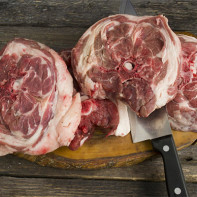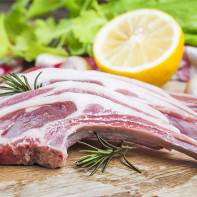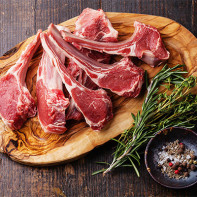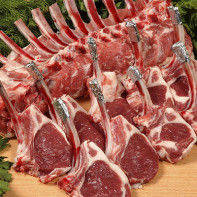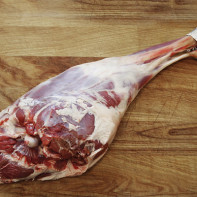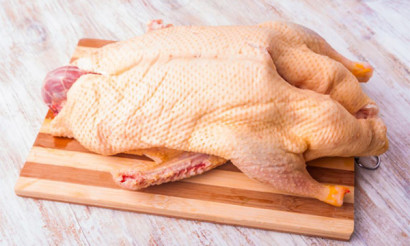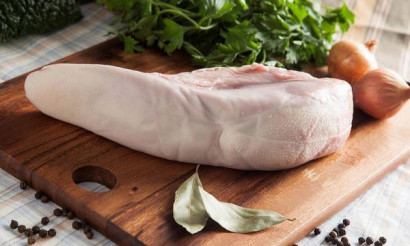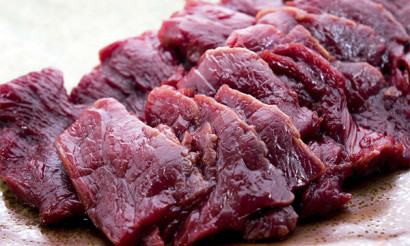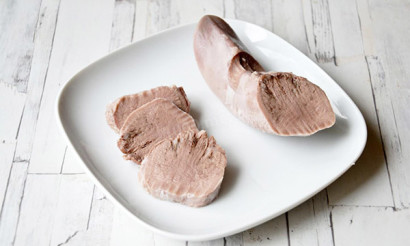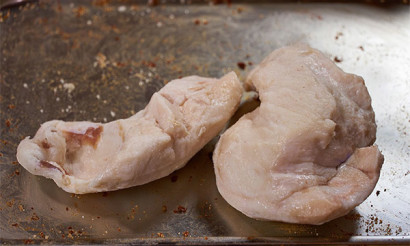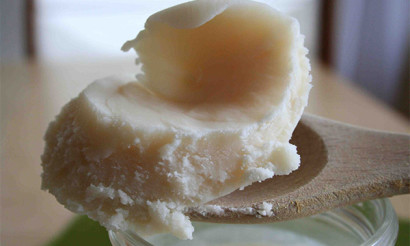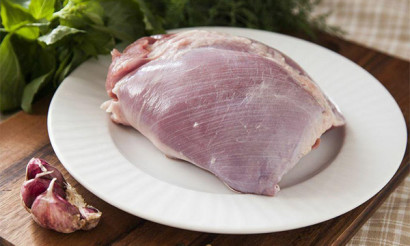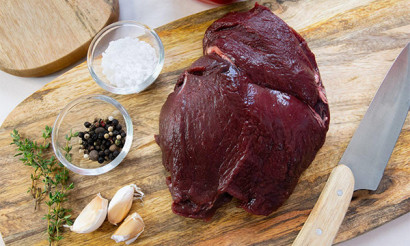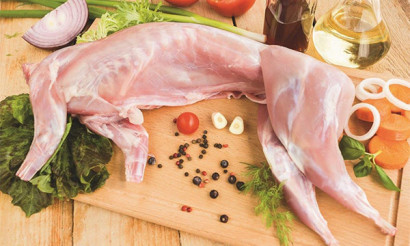Lamb meat: useful properties and contraindications
Mutton is the meat of rams and sheep. The greatest value are the carcasses of castrated animals under the age of one and a half years. In the category of products with high taste qualities also include meat of sheep under the age of 3 years. The product has a light red color, elastic and white fat mass. Meat of poorly fattened or mature animals has a dark red color and yellow fat mass. As a rule, it is very stringy, so most often it is made into minced meat. Let's consider in more detail this type of meat, its distinctive features and useful properties.
- How to distinguish between mutton and goat meat
- Which meat is healthier
- Lamb or pork
- Lamb or beef
- Lamb or goat
- Composition and calories
- What is lamb good for?
- General benefits
- For women
- For Men
- While pregnant
- For breastfeeding
- For children
- When losing weight
- The benefits and harms of mutton broth
- What is the liver of lamb good for?
- Lamb in medicine
- Diabetes
- In pancreatitis
- Gastritis
- With gout
- Harm and contraindications
- How to choose and store mutton
- Can I freeze it?
- What can be cooked from mutton: Recipes
- Shurpa
- Cutlets
- Lulu Kebab
- Laghman
- Soup
- Pilaf
- Shashlik
- How to cook
- How to roast
- How to remove the smell of lamb when cooking
- Can we give mutton meat to animals?
- Interesting facts about mutton meat
How to distinguish lamb from goat meat
Sometimes dishonest dealers pass off goat meat as mutton. To avoid making a wrong choice, you should pay attention to the color, smell, bones, and fat of the product. For example, goat meat has almost no subcutaneous and intermuscular fat. It is also worth noting that goat meat has a darker color in contrast to lamb. If the product has a specific pungent smell, it is goat meat.
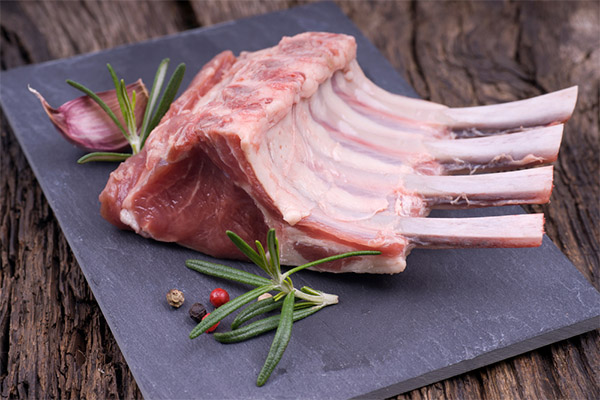
It is necessary to pay attention to the structure of the bone structure of the carcass. Sheep's pelvic and breast bones are thicker than goat's. Mutton ribs across have an oval elongated shape, while goat ribs are quadrangular with two sharp angles.
Which Meat is Healthier
Each type of meat has its pros and cons. For example, the advantage of mutton is that it has less cholesterol compared to beef and pork. At the same time, beef contains a lot of iron, which is useful for people with iron deficiency. Pork is considered to be a record-breaker in cholesterol content, but it contains many times less cholesterol than chicken eggs and butter.
Let's take a closer look at the health benefits of each type of meat.
Lamb or pork
If we compare lamb with pork, it is immediately worth noting that the first has less fat, so this type is allowed to be consumed even with vascular problems. Lamb refers to dietary products, because it has few calories, and also because it is quite easy for the body to assimilate it. At the same time, at an advanced age it is better not to eat this meat. Lamb is undesirable to include in children's diets, as well as in cases of gastrointestinal problems.
If we talk about pork, it contains substances that are beneficial for the bone tissue. At the same time a high concentration of cholesterol has a negative impact on human health. In addition, pig meat needs careful processing, because it can be infected with parasites. The growth hormone it contains increases the risk of obesity, various inflammations and can even contribute to malignant growths. It is for this reason that the constant consumption of pork increases the likelihood of various cancers. Pork is not recommended for consumption in cases of atherosclerosis, cholecystitis and duodenitis.
Based on the above facts, we can conclude that lamb is more beneficial for humans, because the risks of negative consequences after its consumption are lower.
Lamb or beef
In order to accurately determine the usefulness of a particular type of meat, it is necessary to know the conditions of maintenance and nutrition of the animal. It can be assumed that both lamb and beef were kept in similar conditions and consumed exclusively natural feed. The first nuance is that cow meat is rich in proteins, so it is recommended to include it in the diet of athletes. Beef normalizes the gastrointestinal tract and maintains normal acidity levels. It also perfectly satiates a weakened body, helps to get stronger and gain strength.
Lamb has a higher concentration of iron than beef, in addition, it has potassium, which supports the heart. It is calorie-dense, but it is more valuable because it contains many nutrients. It contains vitamin B12, which normalizes the nervous system. The energy value of the product depends largely on the age of the animal. The greatest value is the meat of young individuals - lamb and veal.
In conclusion, it can be said that it is quite difficult to choose a more useful and nutritious product, because both the first and the second type of meat have their own advantages. Although lamb is considered a caloric product, it still contains less cholesterol, so it is safer for the heart system.
Lamb or goat meat
Goat meat contains a lot of unsaturated fatty acids, minerals, amino acids with a small concentration of cholesterol. A distinctive feature of this type of meat is the absence of parasites. Cattle are prone to worms and other parasitic organisms, while goat meat lacks both larvae and full-grown parasites. This meat belongs to the dietary products. Goat meat is useful for spinal problems because it helps repair connective tissues. Regular consumption of goat meat reduces the risk of liver disease. According to experts, goat meat exceeds the value of lamb meat.
Composition and calories
100 g of the product contains:
- calories - 209 kcal;
- protein - 15.6 g
- fats - 16,3 g;
- Carbohydrates - 0 g.
Lamb contains B vitamins, which play an important role in processes related to metabolism. Vitamins of this group, not including B12, do not accumulate in the body, for this reason it is necessary to constantly replenish their reserves. If we talk about micro- and macronutrients, meat contains potassium, sodium, magnesium, phosphorus, calcium, fluorine and zinc.
Lamb contains one-third more iron than other meats. The product is also rich in amino acids, which the body needs for tissue formation. Most of the fats present in the meat are healthy monounsaturated fats.
What is useful for lamb
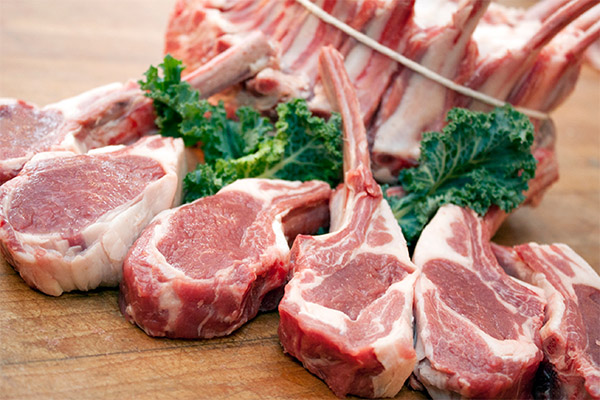
General benefits
- Fights cancer. Lamb is an excellent source of iron, vitamin B, choline, and selenium. Choline and selenium reduce the risk of malignant tumors in internal organs. It also contains conjugated linoleic acid. Conjugated linoleic acid performs many important functions in the human body, such as delaying the formation of atherosclerotic lesions, reducing fatty tissue, suppressing the development of type 2 diabetes, improving bone mineralization, bacteriostatic, antioxidant and anticancer effects. But this substance is most effective in the fight against cancer. Acid suppresses the development of melanomas, colon, rectum, lung, and breast cancer.
- It is a prophylactic for anemia. The main cause of anemia is the lack of iron in the body. Lamb meat contains quite a lot of iron, so if you eat this product regularly, you can avoid this disease.
- Maintains the health of the skin. Vitamin B12 contained in lamb helps maintain healthy skin. The product also contains omega-3 unsaturated fatty acids, which promote skin elasticity and retain moisture in the skin.
- It is a rich source of carnosine. Lamb is an excellent source of an amino acid such as carnosine. Although the human body can produce this amino acid itself, it is also useful to get it from external sources. First, carnosine has a powerful anti-atherosclerotic effect that reduces the likelihood of fatty plaques forming inside the walls of blood vessels. This significantly reduces the risk of cardiovascular disease, including heart attack and stroke. In addition to this, it also fights inflammatory processes, reducing their negative effects on the body. This indirectly helps to prevent premature aging.
- It supports the body's antioxidant system. Lamb meat can help support the neutralization of free radicals because it contains such a substance as glutathione. Some experts call this compound one of the most effective antioxidants produced by the human body. It replenishes antioxidant reserves in case of deficiency and also helps in combating the harmful effects of free radicals.
- It promotes stamina and performance. In addition to protein, which helps support muscle growth and repair, lamb is rich in other substances that support muscle tissue and overall body tone. In particular, the product contains the amino acids beta-alanine and creatine, a well-known performance enhancer. Enriching your diet with these amino acids gives you strength, reduces fatigue, improves performance and buffers lactic acid, which is known to cause "burning" in muscles during exercise.
- Supports immunity. The presence of zinc in lamb meat has a beneficial effect on the immune system because it helps support many of the enzymatic reactions that help destroy pathogens. It is also worth noting that it promotes healing and minimizes scarring. Active people especially benefit from eating mutton, as it replenishes zinc reserves that are lost during physical activity.
- It maintains the health of the nervous system. It needs a constant supply of sufficient nutrients. Lamb enriches the body with B vitamins and fats, which are essential for maintaining a healthy nervous system. B vitamins help in impulse transmission and in preserving nerve sensitivity, especially important for peripheral nerves that may have impaired circulation. Fats provide maintenance of the insulating sheath of nerve fibers, thereby preventing loss of electrical signal during transmission.
- Maintains bone health. Lamb is very good for bones and teeth. The meat contains calcium compounds that support bone formation and growth in children, and reduces the likelihood of osteoporosis in adults. In addition, the product is rich in phosphorus. It also plays a vital role in forming and maintaining healthy bones and teeth, is involved in tissue growth and regeneration, and helps maintain normal blood pH levels.
For women
Lamb is good for women because it improves the appearance of skin, hair, teeth, supports the body's immune system and speeds up metabolic processes, which helps to control body weight. In addition, with regular consumption of mutton meat you can get rid of dizziness during menstruation. Vitamins contained in the product contribute to strengthening the skeleton and help in hematopoiesis, thereby improving the overall health of women.
For men
The components that make up mutton have a complex effect on the human body, and they are especially useful for members of the male half of the population. The most important properties of mutton for men are strengthening the nervous system by increasing stress resistance and stabilization of the moral state (men often suppress their emotions, and thus are subjected to latent depression).
In addition, lamb meat helps increase potency, enhances sexual desire and stimulates testosterone production. The product also improves the digestibility of protein foods and helps to distribute them evenly throughout the body, which is useful for sports activities.
Pregnancy
It is allowed to eat mutton during pregnancy, because it contains folic acid, which is responsible for the development of nerve cells in the fetus. This acid is often prescribed to women in the position. In addition, meat is rich in zinc, which is responsible for child growth, vitamin B12, which supports fetal immunity, as well as manganese and copper - substances that support the normal development of the embryo. But if the measure of consumption is violated, there will be negative consequences, such as increased blood pressure.
When breastfeeding
Because lamb meat is quite fatty, it should not be included in the diet when breastfeeding. However, some experts permit the consumption of meat, but only if certain rules are followed. The first is that mutton can be eaten only 4 months after childbirth. The first time is allowed to eat only broth. If the baby does not have any negative reactions, then the meat should be introduced into the diet with a gradual increase in portions. After some time, the portion can reach 150 grams per day, but no more.
For children
Mutton is also useful for children. However, it is not recommended to include it in children's diets until the child is 1 year old. Some experts prohibit eating this product until the age of 3 years. If the baby has a weak digestive system, then acquaintance with meat should be postponed until 3 years. Before cooking, all fat must be removed from the meat. In case of allergic reactions it is necessary to exclude mutton from the children's menu, and it is recommended to consult a doctor.
For weight loss
When losing weight, mutton meat can be used, and in some cases it is even necessary. The meat contains relatively little fat and cholesterol, while the fats in the product contribute to the release of energy and do not lead to gaining extra pounds. Naturally, we must not forget that the useful properties of the product will not benefit in case of excessive consumption. So that the product does not harm the body and does not disrupt the weight loss process, you should not eat more than one small piece of meat per day.
The benefits and harms of lamb broth
The useful properties of broth based on mutton are known to many. It is usually included in children's diet for problems with the cardiovascular system and the gastrointestinal tract. Due to its low cholesterol content, broth is also used for atherosclerosis and other diseases related to the heart and blood vessels. Meat broth is useful in case of low hemoglobin or anemia.
If we talk about the harm of the product, it is contraindicated in diseases of the liver, kidneys, in the case of gallbladder problems and gastritis with high acidity. Restrictions also apply to diseases such as gout, stomach ulcers, arthritis.
What is lamb's liver good for?
The liver is considered the most valuable and useful element of lamb carcass, because it contains vitamins A and C. In addition, liver contains such a substance as heparin, which provides normal blood clotting, which significantly affects the risk of myocardial infarction. It also contains a valuable protein that ensures proper functioning of the human body. This product should be included in the menu of professional athletes, because the minerals it contains help accelerate the process of building muscle mass.
Mutton in medicine
In folk medicine, mutton fat is used for the prevention and direct treatment of colds, flu and sore throat. In addition, the meat helps with gastrointestinal problems and heart problems.
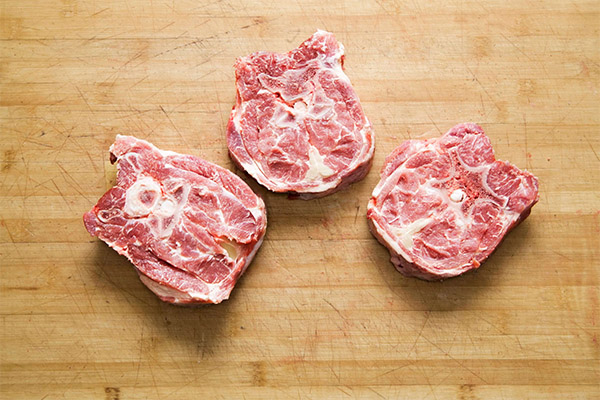
For diabetes
In diabetes, it is recommended to consume lean lamb, as it is the ideal solution for meat nutrition in this case. The substances contained in the product help to control the processes associated with the production of gastric juice, which in turn facilitates the functioning of the pancreas. In addition, thanks to lecithin, a substance found in meat, it can be used to prevent the development of diabetes.
Important: The glycemic index of lamb meat is 0 units.
In pancreatitis.
As the meat contains fat, it should be avoided during the aggravation of the disease. In the case of stable remission, the use of mutton is allowed, but cautiously and infrequently. Only stewed or boiled mutton may be eaten.
In case of gastritis
In case of gastritis, mutton is not recommended to eat, but it is not prohibited either. In any case, in the case of an exacerbation of the disease, meat should not be eaten. But in the case of the transition of the disease to the remission stage, from time to time you can afford lean lamb.
In case of gout
At gout, as is known, it is forbidden to eat products that are rich in purines. This list includes meat, and therefore lamb. Therefore, eat meat product in this case should be either with great caution, or do not use at all.
Harm and contraindications
It is also worth mentioning the harm of mutton. This type of meat is contraindicated in cases of:
- obesity;
- Chronic gastrointestinal diseases, liver and kidney diseases;
- Gout and arthritis of the joints;
- Atherosclerosis.
Also, the meat is not recommended for use in young children (under 2 years) and elderly people.
How to choose and store lamb
The main signs of a quality product:
- light fat layer (means the meat is young);
- Uniform color;
- Firmness: meat should return to its former shape if pressed with the finger;
- Good and strong flavor and no extraneous aromas;
- coarse-grained texture;
- White bones; in very young lambs the bones may have a pinkish tint;
- A small amount of fat, the meat is well visible veins;
- absence of blood, the meat is slightly moist and shiny.
You should also pay attention to the ribs of the carcass: the greater the distance between them, the older the animal was.
Lamb can be stored in the refrigerator. Small pieces of meat may be stored for up to 3 days at temperatures down to -5°C. After that time, it is no longer recommended to freeze lamb. Large pieces of meat retain their freshness in the same conditions for up to 4 days. At room temperature, lamb can be stored for only a few hours.
Can I freeze
It is possible to freeze meat. When frozen, it can be kept in the freezer for about six months. Usually the product is chilled before freezing. To do this it will be enough to put it into the freezer for 1-2 days. Then the meat should be tightly packed in cling film and sent to the freezer. The storage temperature is -4-7°C.
What can be cooked with lamb: Recipes
Shurpa

Ingredients:
- lamb meat - 2 kg;
- potatoes - 2 kg;
- carrots - 2 pcs;
- onions - 2 pcs;
- sweet bell pepper - 2 pcs;
- dill and cocklebur - 1 bunch each;
- garlic - 2 heads;
- oil (vegetable) - 10 tbsp;
- salt - 1 tbsp.
How to cook:
- Chop the onion, cut the carrots and peppers into cubes (1 by 1 cm), potatoes - in halves. Peel the garlic from the husk, teeth do not separate.
- Cut the meat into medium-sized pieces. Take off meat from bones. Chop large bones into small pieces.
- Pour oil in a cauldron and heat it.
- Add carrots and onions. Stirring, fry the onions until golden.
- Put there lamb. Put on high heat. Stir-fry until crusty (to avoid blood).
- Salt and add lamb seasoning (season to taste). Stir-fry for about 10 minutes.
- Pour cold water (about 4 cm up to the edge of the cauldron).
- Cover and let simmer (up to 40 minutes), stirring occasionally.
- Add potatoes (up to 12 per medium wok).
- Stir, add bell peppers 7-9 minutes before potatoes are ready.
- When potatoes are ready, add dill and parsley and leave on low heat for 5 minutes. Then add the garlic cloves, not separated into cloves.
- Rake the coals, leaving the cauldron over the fire, and do not let the shurpa cool down. Pour it onto the plates.
Cutlets
Ingredients:
- minced mutton - 600 gr;
- onions - 400 gr;
- garlic - 5 cloves;
- eggs - 2 pcs;
- oil (vegetable) - 80 ml;
- flour (wheat) - 6 tbsp;
- Greens - 1 bunch.
How to cook:
- In a blender, place clean and dry herbs, peeled garlic and beat until a homogeneous pulp.
- In a blender add bell peppers (optional), spices (to taste), half onions, beat 1 egg and bring to a smooth pulp.
- In the mush add minced meat, salt, pepper, beat the remaining egg and mix.
- Moisten your hands and form from the minced meat into small patties (up to 70 g).
- Put the minced meatballs covered with wheat flour and place it on a griddle (with vegetable oil). Roast on medium heat for up to half an hour.
- Add a side dish of fresh vegetables to the hot lamb cutlets and serve.
Lulah Kebab
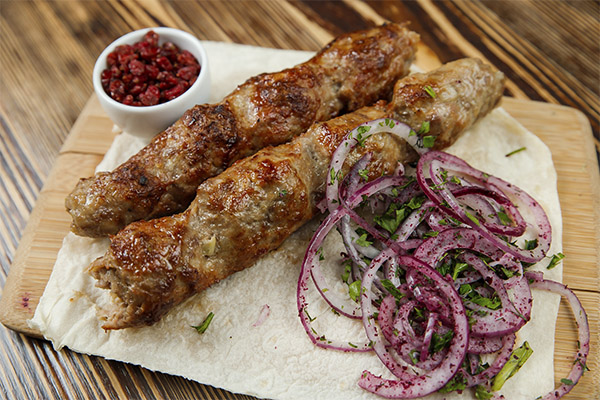
Ingredients:
- Lamb (fresh or chilled) - 1 kg;
- turkey fat - up to 20 g;
- onions - 3 units;
- coriander, salt and black pepper (to taste).
How to cook:
- Wash the meat with cold running water. Remove all membranes and sinews. Put it on a cutting board and cut into pieces 5 by 7. Pass through a meat grinder (through the medium grinder).
- Peel, wash onion and cut into small cubes (up to 0.3 cm).
- Add the fat and onion to the mince. Wash your hands and mix it well. Chop the coriander and add to the bowl with the black pepper. Then stir the minced meat for 8-10 minutes by lifting and throwing the mass in the bowl. After that put it for 1-2 hours in the fridge.
- Make balls (up to 70 g each) from the cooled minced meat, moistening your hands with cool water. Shape balls into sausages (up to 15 cm long).
- Thread them on a skewer (1 sausage - 1 skewer), salt and distribute the meat evenly over the skewer.
- Roast on coals for 10 minutes (without flame), while the skewer should be constantly turned.
Serve hot.
Laghman
Ingredients:
- lamb meat - 1 kg;
- vegetable oil - 20 ml;
- garlic - 6 cloves;
- tomato - 3 pcs;
- Sweet bell pepper - 1 pc;
- noodles - 300 g;
- onions - 4 heads;
- carrots - 2 pcs;
- Greens, pepper, black pepper (ground).
How to cook:
- Cut the washed and dried meat into large cubes, add salt and salt.
- Pour vegetable oil into a frying pan (deep), add chopped onion and meat, fry until crispy.
- Peel and cut carrots into large julienne strips, peppers and tomatoes into small cubes. Peppers and carrots put to meat in pan, salt, add boiling water and put on small fire, stirring.
- When the meat is ready, add the tomatoes and stir.
- Peeled and cut into halves garlic and pepper peas add to the meat.
- Boiled in salted water and rinsed in a colander, place noodles on plates. Put meat and vegetables on top. Sprinkle with chopped greens and serve.
Soup
Ingredients:
- Lean lamb - 300 gr;
- onions - 1 pc;
- garlic - a few cloves;
- potatoes - 200 gr;
- carrots - 1 pc. (large);
- tarragon - up to 70 g.
How to cook:
- Cut the washed meat into slices (40 g each). Put the lamb in a pot, pour water and cook until tender (do not forget to remove the foam). After cooking, strain the broth.
- Cut peeled potatoes and carrots into large cubes, shred onions and fry in vegetable oil.
- Put boiled lamb, potatoes, carrots and onions in broth. Salt and pepper it. Cook soup until potatoes are ready.
- Add finely chopped tarragon and peeled chopped garlic cloves after readiness of the soup.
- Serve up.
Pilaf
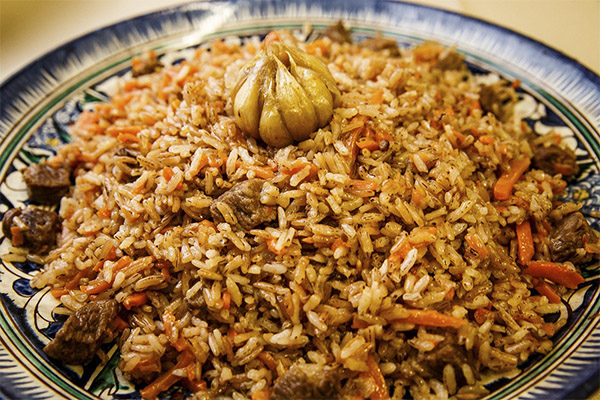
Ingredients:
- rice - 1 kg;
- lamb meat - 1 kg;
- carrots - 1 kg;
- vegetable oil - 300 ml;
- onions - 4 pcs;
- hot dry pepper - 2 pcs;
- garlic - 2 goals;
- barberry (dried) - 1 tbsp;
- zira - 1 tbsp;
- coriander (seeds) - 1 tsp.
How to cook:
- Wash the rice several times. Cut the washed lamb into cubes. Peel onions (3 pcs.) and carrots. Onions cut into thin half rings, carrots into long bars (up to 1 cm thick). Remove the husks from the garlic, but do not divide the cloves.
- Heat the cauldron, add the oil and heat it until there is light smoke. Add onions (1) and fry until blackened, then remove from the cauldron.
- Make the base of the pilaf. Stir-fry the onions until golden-dark (about 7 minutes). Add lamb and stir-fry until crispy.
- Add carrots and stir-fry for about 3 minutes. Stir and leave to stand for 8 to 10 minutes, stirring occasionally.
- Add crushed cumin, coriander seeds, barberry and salt.
- Cook over medium heat until the carrots soften (up to 10 minutes). Pour boiling water into the cauldron (about 2 cm layer). Add hot pepper. Reduce the heat and simmer for about 60 minutes.
- Rinse the rice again, waiting for the water to drain. Place the rice layer in the base of the pilaf and turn the heat up to high. Using a slotted spoon, add boiling water to cover the rice layer (3 cm).
- After the liquid is absorbed into the rice mass, squeeze in the garlic cloves and cook over medium heat until tender.
- Lightly tap the rice with a slotted spoon. If it sounds muffled, poke a few holes in the rice.
- After smoothing the surface, place a plate on top and a lid on top as well. Put the pilaf on minimum heat for half an hour.
What part of lamb is better for pilaf
In addition to shin, you can use any part of the lamb. In restaurants, the most expensive and softest parts are usually used - the loin and loin. For home cooking, ribs, neck and shoulder will do.
Shashlik
The most popular and proven recipe is kebab of lamb with vinegar. This method of cooking helps to soften all the veins, so the meat will turn out soft and juicy.
What part of lamb is better for kebab
The most suitable part of the lamb for kebab is the loin. You can also use the fleshy back part of the leg or ribs.
How to marinate lamb on a kebab
Ingredients:
- lamb - 0,5 kg;
- onions - 3 pcs;
- vinegar (9%) - 1 tbsp;
- olive oil - 1 tbsp;
- mint - 1 sprig;
- parsley - 1 bunch.
How to cook:
- Cut the meat into portions for the kebab. Remove veins and membranes, wash under running water and put into a container, preferably a deep one. Salt and pepper it, pour in vinegar and olive oil. Stir well.
- Peel the onion and cut into rings. Tear the greens into small pieces.
- Add the onions and herbs to the meat, stirring until juices appear. Then put lid on and leave in cold place. Let it marinate for about 8 hours.
How to Boil
Ingredients:
- turnips - 1 pc;
- onion (onions) - 2 heads;
- carrot - 2 pcs;
- water - 2 liters;
- lamb meat - 500 g;
- salt - 1 tsp;
- spices - 2 tsp.
How to cook:
- Wash the meat and put it in a pot. Pour boiling water so that it completely covers the lamb.
- Cover with a lid and put to boil. After boiling, turn down the heat.
- Chop vegetables and add to the pot. The foam from time to time it is necessary to remove.
- Meat of a young animal to simmer for about an hour and a half, adult - up to 2.
How to fry
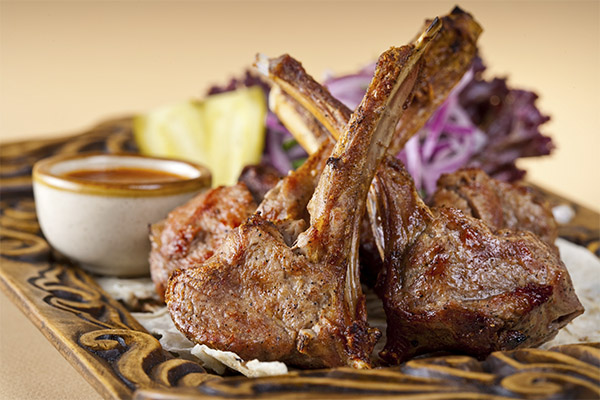
Ingredients:
- lamb (with a layer of fat) - 600 g;
- onions - 2 units;
- parsley, basil and vegetable oil.
How to cook:
- Wash and dry the fillet, cut into strips (thickness - 1 finger, length - up to 5 cm).
- Heat a frying pan, pour oil, after a minute put the meat there as well. Stir-fry for up to 3 minutes.
- Reduce heat to medium.
- Add boiling water to the level of the meat.
- Leave the lid on, and simmer until all the water has gone (about 25 minutes).
- Add fresh onion chopped in half rings, salt, pepper and add herbs.
- Fry for 10 minutes until the meat is blanched.
How to get rid of the smell of lamb when cooking
To get rid of the smell of lamb, you need to soak it in vodka. To do this, pour the prepared meat with ordinary vodka and leave it for several hours.
Can we give mutton meat to animals?
Dogs can be fed mutton. This type of meat is present in many dry foods. The pet's body can easily digest fresh raw meat. Lamb should not be included in the basic diet of cats, as the meat is too fatty for them. However, as a small addition to the menu, the product is quite acceptable.
Interesting facts about lamb meat
- For Muslims, mutton is an integral part of the daily menu.
- Lamb is an animal up to 10 months of age.
- In lambs older than 2 years, the meat has a dark maroon color, in addition, it is quite tough.
«Important: All information on this site is for informational purposes only. purposes. Consult with your health care professional before applying any recommendations. specialist before using the recommendations. Neither the editors nor the authors shall be liable for any possible harm caused by materials."

